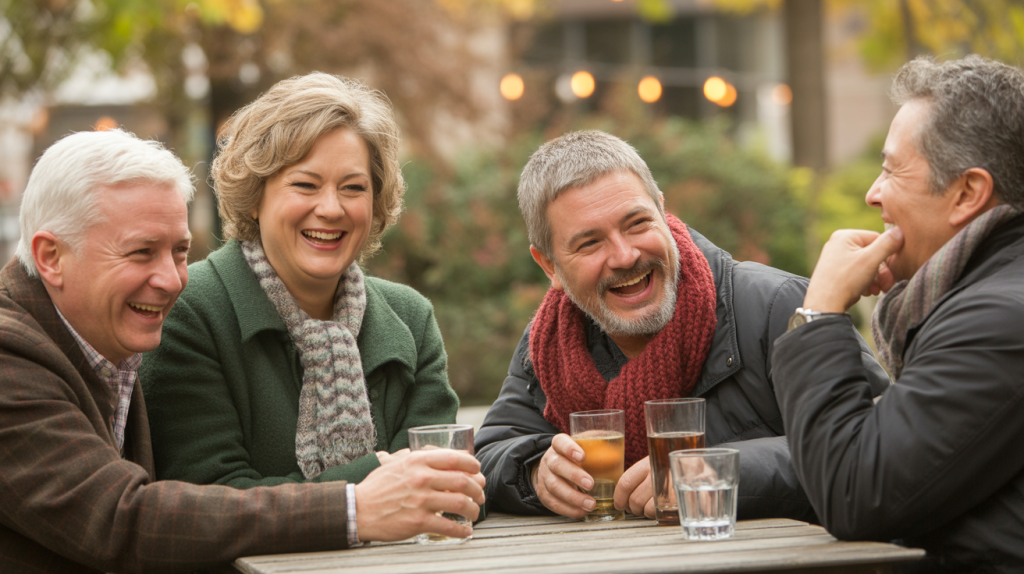It’s funny how life can chug along, smooth and predictable, for years, and then suddenly, you hit a bump. Or in my case, it felt more like a series of jolts – the kind that rattles your teeth and makes you grip the steering wheel a little tighter. For me, that jolt came in the form of rising costs. Not just one thing, but a creeping, persistent increase in the price of almost everything that makes up daily life.
I’m not someone who typically obsesses over every penny. I’ve always tried to be responsible, save a bit, and live within my means. But my “means” started to feel like they were shrinking, even though my income hadn’t changed. The culprit? Those headlines we all see: inflation, supply chain issues, global events. Abstract terms, until they hit your grocery bill and your gas tank. Then, they become very, very real.
This isn’t a story about intricate financial wizardry or extreme couponing. It’s a much simpler, more personal tale of how I, someone who valued convenience and perhaps took stable prices for granted, had to fundamentally change my everyday habits. It’s about how grocery inflation and soaring fuel prices pushed me out of my comfort zone and, surprisingly, into a way of life that’s not just more economical, but in many ways, richer.
The Wake-Up Call: When “Normal” Stopped Being Normal
I remember the exact moment the fog of my old spending habits began to clear. I was at the gas station, a place I used to visit without much thought. The pump clicked off, and I glanced at the total. My heart did a little flip. It was a number I associated with filling an almost empty tank, but I’d only been on a quarter full. “This can’t be right,” I thought. But it was. That was the first real punch to the gut.
Then came the grocery store. For years, I had a rough mental estimate of what my weekly shop should cost. It wasn’t precise, but it was a comfortable range. Suddenly, that range was a distant memory. I’d walk out with fewer bags, yet the receipt showed a significantly higher total. A carton of eggs, a staple, had nearly tripled in price. A loaf of my favorite bread was creeping up by dollars, not cents. Even basic produce seemed to have luxury price tags.
I’d come home, unpack my groceries, and feel a knot of anxiety tighten in my stomach. It wasn’t just about the money itself; it was the feeling of losing control. My carefully managed budget, the one that had always worked, was starting to unravel. I’d always considered myself pretty savvy, but this new economic landscape felt alien and hostile.
My evenings often involved takeout or a quick, pre-prepared meal from the supermarket. Cooking, for me, was often a weekend affair, a hobby rather than a necessity. Driving was my default mode of transport. Need to pick up a prescription? Drive. Meet a friend for coffee? Drive. A quick trip for that one forgotten item? Drive. I never really tallied up the cost of that convenience, either in fuel or in the premium price of ready-to-eat food.
The realization that my established spending behavior was no longer sustainable was a slow, dawning horror. It wasn’t a single epiphany but a series of uncomfortable truths stacking up, demanding attention. There was a period of denial, I’ll admit. I hoped it was temporary, a blip that would soon correct itself. But as weeks turned into months, it became clear that this was the new reality I needed to confront.
Tackling the Tyranny of the Gas Pump
My car, once a symbol of freedom and convenience, started to feel like a drain on my resources. Every trip, no matter how small, now came with a mental calculation: “Is this worth the gas?” This was a completely new way of thinking for me. Previously, if I wanted to go somewhere, I just went.
The first change I made, and perhaps the easiest, was to consciously reduce my driving. This wasn’t about giving up my car entirely – that wasn’t practical for me – but about being much more intentional with its use.
I started with what I called “errand batching.” Instead of making multiple small trips throughout the week, I designated one or two days for all my errands. I’d sit down with my to-do list and a map (yes, sometimes an actual map, or at least the map app on my phone) and plan the most efficient route to hit the post office, the pharmacy, the bank, and the library all in one go. It sounds almost ridiculously simple, but it was a departure from my old, more spontaneous habits.
There was a learning curve. I’d forget things, or an unexpected need would pop up, tempting me to make that “just one quick trip.” It took discipline to say, “No, that can wait until my next scheduled errand day,” or to find an alternative. Could I call instead? Could I order it online for delivery if the item wasn’t urgent and the delivery cost was less than the gas? These were questions I’d rarely asked myself before.
Then, I started looking at my shorter trips. The local hardware store, just over a mile away. The friend I met for coffee, a pleasant twenty-minute walk. I’d always driven these routes out of habit. So, I dusted off my walking shoes. At first, it felt a bit like a chore, especially if the weather wasn’t perfect. But then, something wonderful happened. I started to enjoy it. I noticed details in my neighborhood I’d never seen from behind a car window – a beautiful garden, an interesting piece of architecture, the friendly nod from a fellow walker.
I live in an area where public transport isn’t particularly robust, so that wasn’t a major option for me, but I know for others, rediscovering buses or trains can be a huge cost-saver. For me, it was about maximizing the trips I *did* take and eliminating the unnecessary ones.
The impact wasn’t just on my wallet, though seeing the gas gauge move slower was a definite relief. I felt a small sense of accomplishment. I was taking active steps, however modest, to counteract the financial pressure. And the extra walking? An unintended but welcome health benefit. I felt more energetic, and the fresh air did wonders for my mood. It was a reminder that sometimes, the solutions to our problems are simpler than we imagine, often involving a return to more basic, less resource-intensive ways of doing things.
Of course, there were frustrations. Sometimes, my carefully planned errand day would be derailed by an unexpected closure or a forgotten item that truly was urgent. There were days I missed the sheer ease of just hopping in the car. But the growing awareness of how much I was saving, both in money and in a less tangible sense of frantic rushing, kept me motivated.
One of the biggest lessons from this part of my journey was about distinguishing between a want and a need when it came to convenience. Did I need to drive, or did I simply want to because it was familiar and easy? More often than not, I found it was the latter.
The Kitchen Crusade: Battling Grocery Inflation One Meal at a Time
If tackling gas prices felt like a skirmish, confronting grocery inflation felt like gearing up for a full-blown campaign. This was where the bulk of my discretionary spending seemed to evaporate, and where I felt the most significant impact of rising costs.
My old grocery routine was, frankly, haphazard. I’d wander the aisles, picking up what looked good, often without a list, and almost certainly without checking prices systematically. Convenience foods – pre-cut vegetables, marinated meats, ready-made sauces – were my allies in getting a quick meal on the table. Takeout was my backup plan, used more frequently than I cared to admit.
The first step was acknowledging the problem head-on. I started tracking my grocery bills meticulously for a month. The total was shocking. It was a stark, undeniable number that screamed, “This has to change!”
So, I decided I needed to cook. Not just occasionally, but consistently. From scratch. This was daunting. While I enjoyed cooking now and then, my skills were basic. My culinary repertoire was limited, and the idea of planning, shopping for, and preparing multiple meals every week felt overwhelming.
My initial forays into more ambitious home cooking were… experimental. There was the time I tried to make a creamy pasta sauce that ended up looking (and tasting) like wallpaper paste. Or the bread that could have doubled as a doorstop. I remember feeling a wave of frustration. “This is too hard,” I thought. “I’m wasting ingredients and time.” It was tempting to retreat to the perceived safety of expensive pre-made meals.
But the memory of those grocery bills, and the growing unease about my financial stability, was a powerful motivator. I knew I couldn’t give up. So, I swallowed my pride and went back to basics. I dug out old family recipe cards, the ones with my grandmother’s spidery handwriting, full of simple, hearty dishes. I turned to the internet, watching videos on basic knife skills, how to properly sauté onions (a revelation!), and how to make a simple vinaigrette.
The real game-changer for me was meal planning. This was something I’d always heard about but dismissed as too regimented. Now, it became my lifeline. Every Sunday morning, I’d sit down with a cup of coffee, a notepad, and the weekly grocery flyers. I’d plan out my dinners for the week, and often lunches too, focusing on dishes that shared ingredients to minimize waste and cost.
This simple act of planning had a cascade of positive effects:
- Focused Shopping: I went to the grocery store with a precise list. No more aimless wandering. This drastically cut down on impulse buys – those sneaky little extras that add up significantly.
- Reduced Food Waste: Because I planned meals around ingredients I had or was buying, I threw out far less food. Leftovers weren’t an afterthought; they were planned for, becoming lunch the next day or components of another meal. That half-used bell pepper? It was destined for a stir-fry later in the week, not to wilt forgotten in the crisper.
- Cost Control: Knowing what I needed allowed me to compare prices effectively. I started paying close attention to unit pricing – that little number on the shelf tag that tells you the cost per ounce or per pound. It was eye-opening to see how seemingly cheaper items were sometimes more expensive in the long run.
- Sales Savvy: I became a student of the sales flyers. If chicken breasts were on sale, I’d plan a couple of chicken-based meals. If a particular vegetable was in season and therefore cheaper, it became a star ingredient. I wasn’t beholden to a rigid menu; I adapted it to what was affordable.
My shopping trips transformed from a source of stress into something more like a strategic mission. I learned to shop the perimeter of the store first, where the fresh produce, dairy, and meats are typically located, and to be warier of the processed foods in the center aisles. I discovered the joys of the bulk bins for things like oats, rice, and spices, where I could buy just what I needed and often at a lower price.
I also had to confront my reliance on expensive protein. Meat, especially beef and certain cuts of chicken, had become incredibly pricey. So, I started exploring alternatives. Lentils, beans, and eggs became my new best friends. I learned to make a fantastic lentil soup that was both incredibly cheap and deeply satisfying. I discovered that a hearty black bean burger, made from scratch, could be just as enjoyable as a beef burger, and a fraction of the cost. I didn’t become a vegetarian, but I certainly shifted to a more plant-forward way of eating, which benefited both my budget and, I suspect, my health.
Cooking itself became less of a chore and more of an engaging activity. I started small, mastering simple dishes and gradually building my confidence. I learned that a roast chicken, while sounding fancy, was actually quite easy to make and could provide several meals: the roast itself, then chicken sandwiches, and finally, a nourishing broth from the carcass.
There were still challenges. Time was a big one. Cooking from scratch undeniably takes more time than grabbing takeout or microwaving a ready meal. I had to consciously make time for it, often prepping ingredients in the evening for the next day’s meal or doing some batch cooking on the weekends – making a big pot of chili or a large casserole that could be frozen in portions for future meals.
But I also found unexpected pockets of enjoyment in the process. The rhythmic chopping of vegetables could be meditative. The aroma of herbs and spices filling my kitchen was genuinely uplifting. There was a deep satisfaction in creating something delicious and wholesome with my own hands, especially knowing it was also saving me money.
One particularly memorable moment was when I successfully baked a decent loaf of bread. After my initial rock-like disaster, I’d almost given up. But I found a simpler recipe, watched a few more tutorials, and tried again. When that warm, fragrant loaf came out of the oven, golden brown and perfectly risen, I felt an almost absurd sense of triumph. It wasn’t just bread; it was a symbol of my ability to learn, to adapt, and to overcome a small challenge. And let me tell you, nothing beats the taste of homemade bread, especially when you know how much the store-bought equivalent now costs!
My kitchen, once a place of quick fixes and occasional ambition, became the heart of my home, a hub of creativity and resourcefulness. The fear and anxiety around grocery inflation didn’t disappear entirely, but it was replaced by a sense of empowerment. I might not be able to control global food prices, but I could control how I responded to them.
The Unexpected Rewards: More Than Just Money Saved
When I first started this journey of cooking more and driving less, my primary motivation was purely financial. I needed to rein in my expenses because the rising cost of living was genuinely squeezing my budget. What I didn’t anticipate were the numerous other benefits that would ripple through my life.
Of course, the financial savings have been significant. By meticulously planning meals, shopping smarter, reducing food waste, and cutting back on unnecessary driving, I estimate I’m saving several hundred dollars a month. That’s money that now goes towards my savings, covers other rising costs like utilities, or simply provides a much-needed cushion and peace of mind. Seeing my bank balance look healthier at the end of the month is a tangible reward for my efforts and a powerful motivator to continue these habits.
But the rewards have extended far beyond my wallet. One of the most noticeable changes has been in my health. By cooking most of my meals at home, I have complete control over the ingredients. I’m using less salt, less sugar, and fewer processed fats than what’s typically found in takeout or pre-packaged foods. I’m eating far more vegetables and whole grains. As a result, I genuinely feel better. I have more energy, I sleep more soundly, and a few stubborn pounds I’d been carrying around seem to have melted away without any conscious “dieting.” The extra walking from driving less has undoubtedly contributed to this too.
Then there’s the acquisition of new skills. I went from being a hesitant, somewhat uninspired cook to someone who genuinely enjoys experimenting in the kitchen. I can now whip up a variety of dishes, understand flavor combinations, and adapt recipes with confidence. This newfound culinary competence is incredibly empowering. It’s a practical life skill that I know will serve me well indefinitely, regardless of economic conditions. There’s a real pride in serving a meal I’ve created from scratch, especially when friends or family enjoy it.
My spending behavior has undergone a permanent shift, and it’s not just about groceries and gas. This whole experience has made me more mindful of consumption in general. I find myself asking, “Do I really need this?” more often, whether it’s a new gadget, an item of clothing, or another subscription service. It’s not about deprivation; it’s about making more conscious, intentional choices. I’ve discovered a certain joy in simplicity, in realizing that happiness and contentment don’t necessarily come from acquiring more things, but from appreciating what I have and making the most of my resources.
Emotionally, this journey has been surprisingly positive. Initially, there was stress and anxiety about rising costs. But as I started to implement changes and see results, those feelings were gradually replaced by a sense of control and accomplishment. Tackling these challenges head-on, rather than feeling like a victim of economic circumstances, has been incredibly affirming. There’s a resilience I’ve discovered in myself that I perhaps hadn’t fully appreciated before.
I’ve also reconnected with a more resourceful part of myself. It reminds me of stories I’ve heard from older generations who lived through leaner times and knew how to make do, to stretch a dollar, to fix things rather than replace them. There’s a wisdom in that approach that I feel we’ve lost somewhat in our culture of instant gratification and disposable convenience.
Looking Back, Moving Forward
If you had told me a few years ago that I’d be meticulously planning my weekly meals, enthusiastically comparing the price per ounce of canned tomatoes, or choosing to walk a mile to the store instead of drive, I would have probably laughed. It wasn’t who I thought I was. But life has a way of surprising us, and challenges often carry hidden opportunities for growth.
The rising costs that initially felt like a burden have, in an unexpected way, been a catalyst for positive change in my life. I’m eating healthier, I’m more active, I’ve learned valuable new skills, and I have a greater sense of financial security and personal agency. My home feels more like a haven, and my kitchen a place of creativity rather than a pit stop.
What this entire experience has taught me, more than anything, is that we are more adaptable and resourceful than we often give ourselves credit for. When faced with challenges, especially financial ones that can feel so overwhelming, it’s easy to feel powerless. But by breaking the problem down, by focusing on the small, everyday choices we can control, we can make a significant difference. My journey started with a shocking gas bill and an expensive grocery run, but it led to a re-evaluation of my priorities and a discovery of a more fulfilling, sustainable way to live.
I know many people are feeling the pinch of grocery inflation and other rising expenses right now. It’s a widespread concern, and it can be particularly worrying when you’re trying to manage a fixed income or protect your savings. My story isn’t a prescription, because everyone’s circumstances are unique. But I hope that by sharing my personal experience – the initial shock, the fumbling first steps, the small victories, and the unexpected joys – I can offer a bit of encouragement. Sometimes, the changes forced upon us can lead us down paths we wouldn’t have chosen, but which ultimately enrich our lives in ways we couldn’t have foreseen.
I still wince a little when I see the price of gas or certain items at the grocery store. But now, it’s accompanied by a quiet confidence. I know I have the tools and the mindset to navigate these economic waves. I’m cooking more, driving less, and honestly, feeling pretty good about it. And that, in itself, is priceless.















